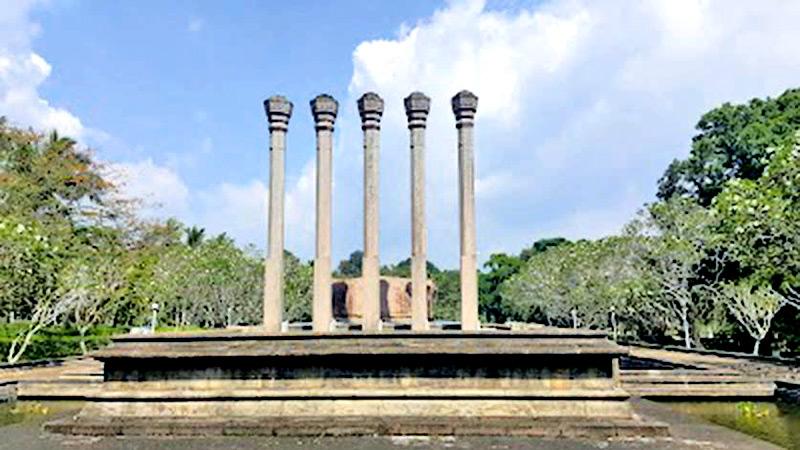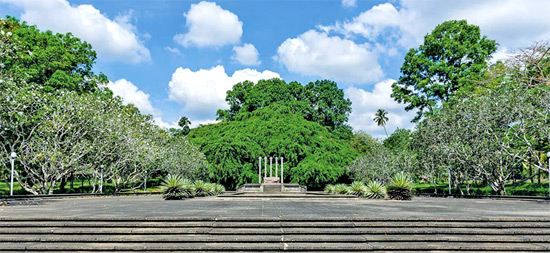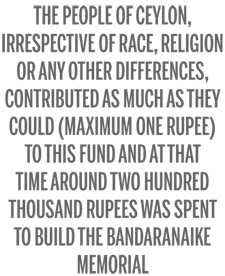
Tombstones are erected in memory of the dead in many countries. In the past, the dead were buried on land owned by the deceased or his family and in addition to the usual burial some have built somewhat larger tombstones.
 People used to build small tombs, while the rich and powerful built large tombs.
People used to build small tombs, while the rich and powerful built large tombs.
In this context, this article is about one such significant tombstone in Sri Lanka.
Monument
You may have seen this monument facing the Colombo- Kandy main road, near the Horagolla Bandaranaike Walawwa.
The fourth Prime Minister of then Ceylon, the world’s first female Prime Minister, and a Minister who was also the Leader of the Opposition and Speaker are buried in this memorial, known as the ‘Bandaranaike Memorial’.
Born on January, 8, 1899 at the Bandaranaike Walawwa in Horagolla, Solomon West Ridgeway Dias (S.W.R.D) Bandaranaike was elected the fourth Prime Minister of Sri Lanka in 1956.
However, less than three years after taking office, on September, 25, 1959, S.W.R.D. Bandaranaike was shot dead by a bhikkhu named Ven.Thalduwe Somarama at the former’s residence in Rosmead Place, Colombo 7.
Surgery
Although he was admitted to the Colombo General Hospital and underwent surgery the following day, September, 26, 1959, the Prime Minister passed away.
The remains of S.W.R.D. Bandaranaike were laid at the Parliament Building (now the Presidential Secretariat) at the Galle Face Green, Colombo for about two days for the public to pay their last respects, after which the remains were placed at the Horagolla Bandaranaike Walawwa.
The body was then buried with the participation of thousands of people at a site near the Horagolla Walawwa facing the Colombo-Kandy Main Road.
Within days after the funeral, a discussion was held to build a special monument to the slain Prime Minister, and construction began in 1959. The manner in which the funds were provided for the construction is also significant.
Following the decision to build this monument at the burial site of the slain Prime Minister Bandaranaike, attention was focused on setting up a fund for it.
Treasurer
Accordingly, the “One Rupee Fund” was set up and was governed by P. B. G. Kalugalle, who was its Treasurer.
The people of Ceylon, irrespective of race, religion or any other differences, contributed as much as they could (maximum one rupee) to this fund and at that time around two hundred thousand rupees was spent to build the Bandaranaike memorial.
 After obtaining the funds, it was necessary to select a designer to build the monument.
After obtaining the funds, it was necessary to select a designer to build the monument.
Therefore, a competition was held and the construction work was handed over to Pani Tennakoon, a well-known architect at that time.
Tennakoon worked on the construction of the monument to reflect the various moments in the life of Prime Minister Bandaranaike. It was planned to build it near a huge Nuga tree where Bandaranaike used to play when he was a child.
Pillars
Pillars can be seen on the monument, which represent the five great forces of bhikkhus, doctors, teachers, farmers and labourers who supported the political movement of Bandaranaike.
In front of the stone pillars is a large granite, beneath which is a platform made of cut and levelled granite.
This granite platform reflects the luxurious childhood of Bandaranaike who was born in the Bandaranaike Walawwa in Horagolla and grew up amid all the comforts.
The rough granite placed on it is meant to reflect the thorny political struggle waged by the young Bandaranaike, who grew up in the midst of all pleasures, only to give it all up and even lose the property he inherited from his parents to fulfill the hopes of the common man.
The ponds on either side of the monument are said to represent peace and tranquility.
There are four staircases made of granite in all four directions and it is said that these four staircases represent the ability and opportunity of anyone from anywhere, irrespective of race, religion or caste, to reach the Bandaranaike principles.
Removed
One of the four staircases is unique since it can be removed when required to enter the Bandaranaike Memorial. It is designed to be removed and reassembled.
After burying the remains of the slain Prime Minister Bandaranaike in the memorial in 1959, it had to be reopened forty-one years later, in October 2000. Sirimavo Ratwatte Dias Bandaranaike, the world’s first Prime Minister and widow of S.W.R.D. Bandaranaike passed away in October 2000 and it was decided to bury her remains in the Bandaranaike Memorial.
However, more than forty years had elapsed since the last opening of the memorial.
Therefore, a problem arose as no one at that time could remember which staircase should be removed.
Eventually, according to the instructions given by elders living in the Horagolla area, the staircase to be removed was identified and the remains of the world’s first female Prime Minister were buried there.
Memorial
Subsequently, the remains of the late Anura Priyadarshi Dias Bandaranaike, the son of the Bandaranaike-Sirimavo couple, a Sri Lankan Minister, Leader of the Opposition and Speaker, who passed away on March 16, 2008, were also laid at the Bandaranaike Memorial.
There are several rooms in the Bandaranaike memorial, three of which now house the remains of Prime Minister Bandaranaike, Sirimavo Bandaranaike and Anura Bandaranaike.
At present, a commemoration ceremony is held at this place on September 26, each year.
Former President Chandrika Bandaranaike Kumaratunga and many family members and politicians also participate in the event.
